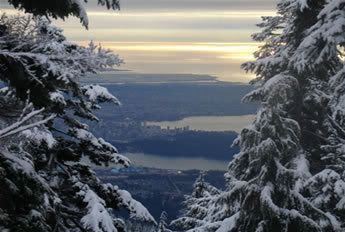
This fantastic photo was taken by Craig from the top of Grouse Mountain - 'The Peak of Vancouver' as the blurb on it's website says. A privately owned mountain, which is an odd concept to me, on top are plenty of ski runs and other entertainments. They got a great day for their trip, as every day after that it was shrouded in rain and mist. We did go for a walk near the base, and could just about see the large gondola cable car whirring into the murk. This view looks due south, with North Vancouver in the foreground, then the green of Stanley Park joined to the downtown, and over the next short stretch of water is Kitsilano where we stayed - the slight green bump in the dead centre of the picture.
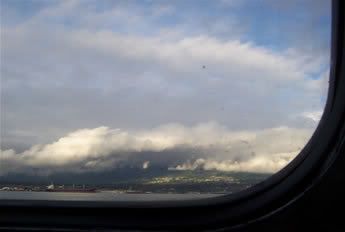
Looking out of the grimy front window of the SeaBus crossing over to the city of North Vancouver, one of the outer suburbs of Vancouver - not to be confused with West Vancouver, which is also to the north. It lies adjacent to the District of North Vancouver, all of which are part of the Greater Vancouver Regional District. By the time you've worked all this out, you're across Burard Inlet and have arrived. The jetty reminded me slightly of Manly, a large floating pontoon with a food court attached. The cloud in the photo was lying over Grouse Mountain, as mentioned above, and the shipping clogging the channel were large tankers making their slow way to the city port. Industrial containers and huge mounds of yellow sulphur for export awaited them.
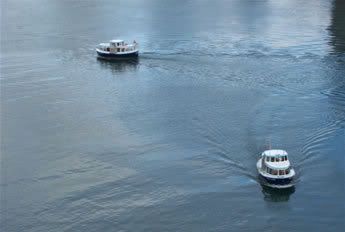
The False Creek Foot Ferries (easier to type than say), ply their dinky trade around the centre of Vancouver. From the bridges over the water they look like toy boats you might play with in the bath, and up close they look just as small. For $2.50, you get a short trip over the inlet that would take half an hour on foot, so they are well worth it. But each one can hold about twenty people at the very most, so they are mainly used by tourists rather than locals. Here's a closer view of them I took on Granville Island before our short jaunt over to English Bay beach. It took about five minutes, but it was well worth it.
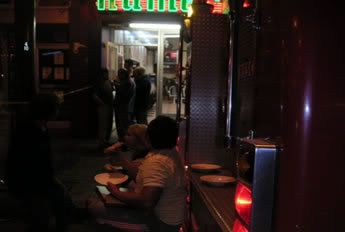
Backpackers getting a free show. Part of the experience of staying in hostels are the fire alarms that (usually) happen at night. Andy took this just after we arrived, and in our sleep-deprived state had gone out for beer and burgers in an attempt to revive us. A cheap backpacker hotel had apparently either had a fire or a false alarm - we weren't sure which - but the fire crews had turned up to give the tall building the once over. Denied entry to their dorms, these guys had grabbed a pizza from next door and were sitting on the back of a fire engine to watch the spectacle.
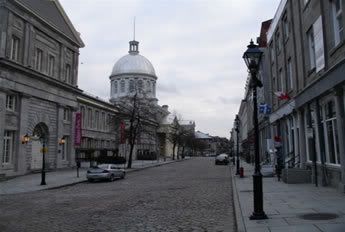
Montréal's old town, or Vieux-Montréal, is one of the oldest urban areas in North America. Some of the buildings date from the 17th Century, and this greenish dome is the Marché Bonsecours, opened in 1847. As any reader who passed Tricoloré-level French at school will know, marché is a market - "Escuse moi, monseur, ou est la marché s'il vous plait?" was my stock phrase learned for a 4th year trip to Normandy (we had to ask someone at least one thing each). From what I can remember, the accosted Frenchman pointed over my shoulder at the large outdoor fruit market we were standing next to, and walked off. No such people to ask here, as Vieux-Montréal was largely deserted on a cold midweek morning.
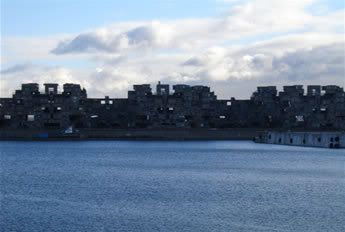
The 1967 World's Fair was held in Montréal after Moscow discovered at the eleventh hour they couldn't bring together the funds needed. The mayor of the growing Quebec city decided to not only host the event, but host it on a series of specially-built islands in the St Lawrence seaway, constructed from the earth excavated when the city's Metro was tunnelled. There were 90 pavilions, including this - the Habitat '67 housing complex on the Quai Marc-Drouin, designed by architect Moshe Safdie. Meant to depict affordable housing of the future, ironically now that future has arrived they are highly sought after and very exclusive. Here is the Habitat '67 website, with pictures of the units themselves, which actually look quite nice close up.